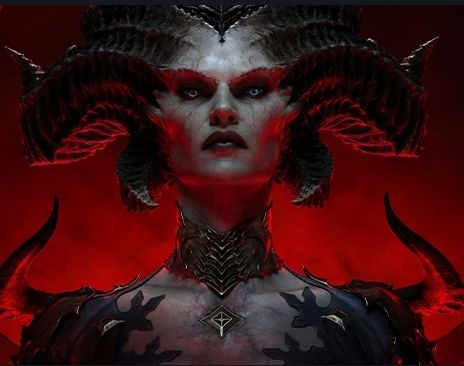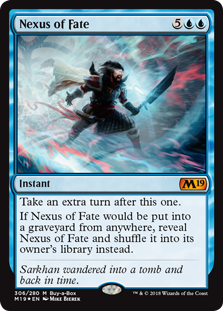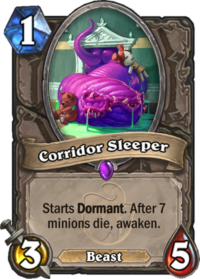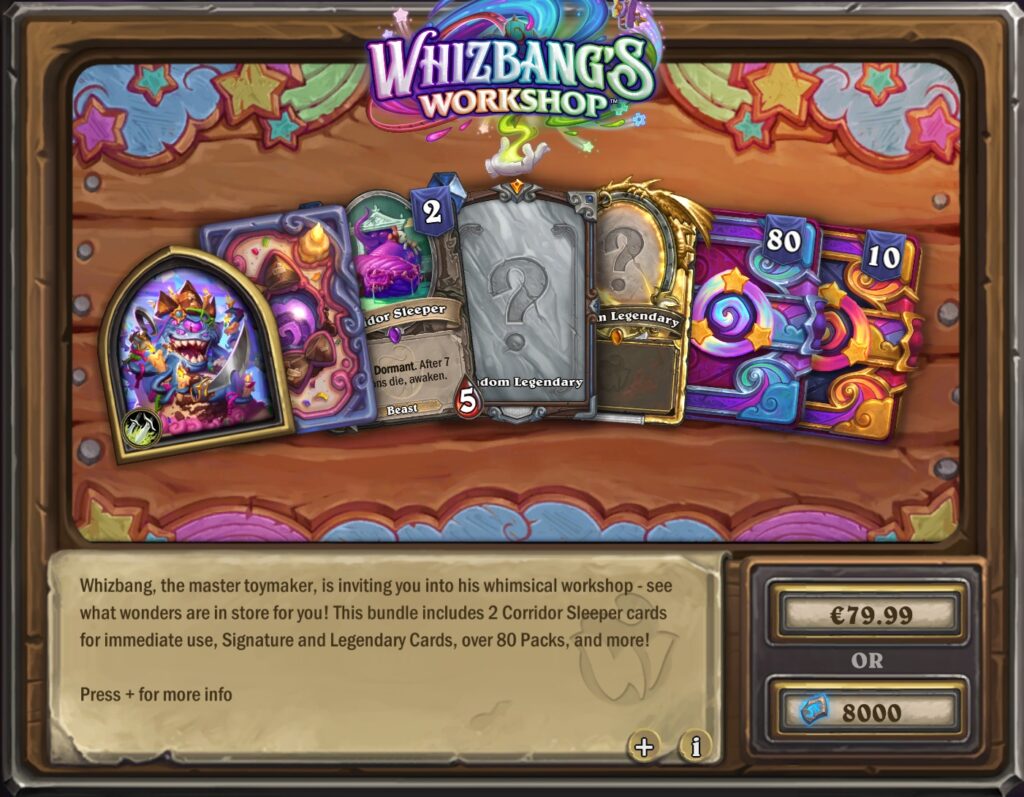Blizzard is doing a lot of interesting things for Hearthstone’s 10th anniversary. The new Core set brings back many old fan favorites and looks to be the strongest one so far. Zilliax Deluxe 3000 allows players to customize their own Legendary card from 28 options. Harth Stonebrew brings back 13 iconic hands from Hearthstone’s past, injected straight into the current Standard format.
But then there’s the creeper in the room. Corridor Sleeper. On the surface, the card looks like a fun throwback to Corridor Creeper, an iconic sleeper card that turned out to be incredibly powerful. It does not quite match the power level of its predecessor, although the card has seen some play in Hunter and Death Knight decks. In Hunter and Death Knight decks of those players who have managed to get their hands on it, that is.
You see, Corridor Sleeper is a card you can play with right now, but only if you buy it with real money. Two copies of this Epic card are offered as part of the Whizbang’s Workshop pre-purchase bundles. If you buy both bundles, you get four copies and can disenchant the extras after the expansion has launched.
It is not exclusive to the pre-order. After the expansion has launched, you can acquire the card like any other Epic card from the new set. However, if you want to play with it in the next month, before the expansion launches on March 19, you will have to pay.
This is a new approach to Hearthstone monetization. This is the first card ever that a free-to-play player cannot play with, even if only for a limited time. Where does this idea come from? How will it affect Hearthstone in the future? Are there any precedents to this kind of practice? Let’s dive deeper into the monetization trends in gaming to find out.
Monetization of Early Access
The idea of making customers pay more to get something sooner is hardly a new one. One example that has been around for decades is the movie industry. You can go watch a movie at the cinema. A little later, you can buy it to watch it at home. Then, it becomes available for rent. And finally, it becomes available for streaming. The earlier you want to watch it, the more you have to pay. It is a model that the movie industry has spent decades working on, and while it was slightly disrupted by the Covid pandemic, the general idea remains.
The game industry has picked up the idea more recently, and it is now one of the top trends in game monetization.
A brief note on terminology here. Early access in gaming has traditionally referred to a period of time when you can buy access to the incomplete game, while development work is still going. This has been used by smaller studios to secure funding to actually complete the game. Now, bigger studios have started to use the same term to refer to a brief period of access to the complete, ready product ahead of its main release, at an additional cost.
 We have seen this with Blizzard already. Diablo IV launched on June 1, 2023. If you paid $90 for it, that is. You could also choose to pay $70, in which case the game launched on June 5 for you. The upcoming World of Warcraft expansion, The War Within, can be bought for $50, but you can also pay $90 to play the game three days earlier and get some additional cosmetic items. There is also an in-between option to pay $70 for most of the cosmetics, but no early access.
We have seen this with Blizzard already. Diablo IV launched on June 1, 2023. If you paid $90 for it, that is. You could also choose to pay $70, in which case the game launched on June 5 for you. The upcoming World of Warcraft expansion, The War Within, can be bought for $50, but you can also pay $90 to play the game three days earlier and get some additional cosmetic items. There is also an in-between option to pay $70 for most of the cosmetics, but no early access.
Blizzard is not alone in this. It is a major trend. For example, you could pay an extra $30 for Starfield to get five days of early access to the game. In case of Starfield, we even have some numbers from Steam that show that the game peaked at over 230,000 concurrent players during its early access period, and there must have been many more overall to reach that concurrent number. For just those 230,000 players, that’s an additional $6.9 million in revenue. This is some very real money that game companies are extremely interested in. It is just free money. They don’t have to do anything for it. Just delay the launch by a few days for people who do not pay extra, and you make millions.
Starfield, by the way, is fully a single-player game. You could not get any competitive advantage from buying early access. It was just printing free money with little worries.
World of Warcraft is a massively multiplayer game, so the stakes are higher. Blizzard has taken some precautions. In particular, the end game content unlocks with a delay, so players who start at launch will be able to level up in time to participate in it on an even footing. This is not a new feature, Blizzard started the practice a long time ago to prevent unhealthy grinding on the first days. Players with early access can still get more familiar with the new expansion, and can level up multiple characters before the end game begins.
People are clearly willing to pay to get access to things earlier. It is a monetization model that has been used for decades, and it has now arrived at gaming in force. I have no doubt that it has also arrived here to stay. However, as you move from single-player games to multiplayer games and free-to-play games, the ethics of its implementation become murkier and murkier.
Card Games with Exclusive Cards?
 It is hard to find a precedent to what Blizzard is doing with Corridor Sleeper from other games.
It is hard to find a precedent to what Blizzard is doing with Corridor Sleeper from other games.
The most illustrative story I can come up with is that of Nexus of Fate from Magic: the Gathering. Nexus of Fate was a promo card from Magic’s Core Set 2019. Specifically, it was a buy-a-box promo card: if you bought an entire box of boosters during the promotional period, you got a copy of Nexus of Fate. That was the only way to get the card.
Fitting to our story, Nexus of Fate was not the first such card. The first card that was available exclusively through buy-a-box, Firesong and Sunspeaker, was mediocre and while it caused some minor controversy, it was soon forgotten. Nexus of Fate was the second such card, and it was good enough to see high-level competitive play. So, the card became quite valuable.
There are some mitigating factors in this story. First, Magic cards cost money anyway. Second, there is a functional aftermarket for Magic cards, so people were buying and selling copies of Nexus of Fate all over the internet. Third, Nexus of Fate is a Mythic Rare, a class of cards so uncommon that there were actually a good number of copies of Nexus of Fate on the market compared to other Mythic Rare cards from the set.
Despite these mitigating factors, the Magic community was not happy. This was a good card that could not be acquired through usual means, and you had to spend a good amount of money to even have a chance to get your hands on one.
History does not repeat itself, but it often rhymes. There are many differences between Nexus of Fate and Corridor Sleeper, but they both broke the fundamental, implicit contract the game company had with its players on how you acquire cards in the game. Also, it is fitting that Nexus of Fate was not the first exclusive buy-a-box promo card. While the first one caused some controversy, it largely died down because actual competition was unaffected. Nexus of Fate showed where things can go, when you make a competitive exclusive card. Wizards of the Coast continued printing exclusive promo cards for Magic for another two years before they gave up because of negative player feedback in 2020.
The Future of Hearthstone Monetization
Blizzard has clearly been looking for a way to improve Hearthstone’s monetization recently. Of course, a company is always working on its monetization practices, but Hearthstone’s developments over the past couple of expansions have been particularly interesting.
The pre-purchase bundles have slowly been made better. In Showdown in the Badlands, Blizzard added a bunch of Catch-Up Packs to the bundles: 20 to the Mega bundle and 10 to the regular bundle. This largely benefited new or returning players, as the value of Catch-Up Packs is great when you have no cards from their expansions, and falls down rapidly to below the value of a regular pack as your collection improves.
Whizbang’s Workshop adopts a different approach. The bundles are the same, but without Catch-Up Packs and with the Epic Corridor Sleepers taking their place. This move provides more value to established players and less to new or returning players.
Phil Spencer, the CEO of Microsoft Gaming, stated in the recent Xbox Podcast that there are two ways to achieve growth. Either you find new players for your games, or you find new ways to monetize your existing player base better. Hearthstone’s approach with Showdown in the Badlands was the former. Hearthstone’s approach with Whizbang’s Workshop is the latter. It is too early to say what the strategy will be like in the future, but this is not a promising sign for the players.
A Mistake That Can Still Be Reversed

Corridor Sleeper will not break the game. It looks somewhat playable, but not in a major role in the meta. You can perfectly well play Hearthstone for the next month even if you do not have it.
However, it also changes something fundamental about the game. The basic, implicit promise for the free-to-play Hearthstone players has been that they can play any deck in the game. Any deck. But not every deck. A free-to-play player will not be able to achieve a full collection, and there is always something they cannot play. But they can craft themselves any individual deck in the game at any time. If something is completely overpowered, every F2P player can build that deck for themselves and remain competitive.
Corridor Sleeper breaks that promise. Now, there is a $50 barrier to play any deck in the game. Sure, this is temporary. Eventually, everyone can get the card. But it is a promise broken, nonetheless.
The case of Nexus of Fate shows us a glimpse of where this can lead. Sure, this time the card is not mandatory. But what about next time? Wizards of the Coast initially said that they would continue exclusive cards and just pay more attention to how strong they are. However, Nexus of Fate was not the last competitive promo card. Maybe Wizards did it intentionally? Or maybe they just failed to see how strong Kenrith, the Returned King was? It is not easy to control the power level of cards so that they entice people to buy but also do not dominate too much. Wizards of the Coast gave up on exclusive promos in Magic eventually, despite early increase in sales.
Blizzard has a choice to make for Hearthstone. They have developed a lot of fun-looking new things for the game for its 10th anniversary. Do they trust that they can make the game fun enough to be worth playing and paying for? Or do they choose to renege on their fundamental free-to-play design? Corridor Sleeper is a step towards the latter direction, albeit one that can still be reversed for the next expansion.


Great article.
And I agree. Been playing this game since like forever, usually f2p. Sometimes I buy a track for the skins. Dissenchant everything.
And I don’t agree with this approach. Obviously I won’t pre purchase, it’s a bad idea, and the reason we love hs is cuz it’s f2p.
Microsoft has nothing to do at blizz, or Bethesda. Bought 2 of the best gaming companies, literally zero new games, and they get even greedier.
What a waste.
I had been playing hs since goblins vs gnomes expansion with reasonable consistency and I had always been a F2P player, this consistency paired with my playtime gave me a collection that is basically indistinguishable from a paying player (except for the cosmetics like portraits and diamond cards and so on).
In, all my years of playing, I have never seen an update that is this scary for the F2P experience, for all the reasons you described in the article. What’s scarier for me is that I haven’t seen much on any platform besides this one talking about it.
It is quite apperent they are testing the waters with this paywall, but seeing the state of current outrage against it (or lack thereof) will no doubt make them push to put more and/or stronger cards behind a paywall. I guess for a player that is paying for the cards every expansion there is no difference at all but for F2P players like me the only logical choice is to quit the game, a 1 month period where you cannot compete against meta decks just because you didn’t pay is simply unacceptable for a game that I play almost daily. They may experiment with shortening that early access period but I personally don’t think that’s a good solution either (will explain why in a second).
Some may be inclined to think that from a business perspective what players like me feel about this news doesn’t matter. If I quit the game 0$ is lost because I had been paying 0$ for years anyway, right? But the fact of the matter is I play a variety of decks and I am a consistent legend player, which means I contribute to the gameplay experience and the competition/ladder experience. If you climbed all the way from bronze to legend, only playing against bots, would you be satisfied with your climb? What if you played against real players instead, but they were playing objectively lower tier decks because they couldn’t buy the tier 0 deck defined by paywalled cards, would you be satisfied then? These are the simple examples but it doesn’t stop there.
If you had been playing for a long enough time you have seen the case where a single outlier deck was significantly better compared to every other deck, forcing the every player to play the same 1 deck, which creates a miserable gameplay experience (dr boom and elysiana control warrior for example). A similar situation is bound to happen if there are multiple tier 1 decks (which suggests a healthy meta on the surface), but imagine if only one of them has all the cards unrestricted by a paywall. In that case the F2P playerbase will not quit but flock to that one deck, resulting in the same situation.
And I have to make one last remark which more personal to me. When the meta is balanced, I simply have fun playing hs. Luckily the meta had been reasonably balanced for many expansions in a row now (and I realise some may not agree with that), but that’s ultimately the reason I keep playing. However I remember the days when noone had early access to anything, and on the first day of an expansion’s launch day everyone experimented with every card, as noone knew what the power levels of the cards were really like, and to me that was when the hs was the most fun. I feel like a drastic portion of that fun had been taken away ever since they enabled the content creators early access, now everyone has a good ballpark idea about what is better and what is worse way before the expansion launches. I feel like putting certain cards behind a paywall and enabling them later will also contribute to fun being lost for this same reason. And even if I was a paying player, I simply don’t see the point in playing the game if it’s not fun anymore.
tbh, all that early access bulls**t annoys me much more than this superbad epic card.
I agree with all statements here that this nonetheless is a very disturbing trend. Regarding the lacking outrage… as sad as it is, I think that nobody is expecting anything positive from Blizz anymore. People just don’t care, they just stop buying / playing. I bought both preorders for years now, but for this expansion, I already planned to bring it down to ‘just’ buying the bigger one – and I’ll do so in March, regardless of the card that is Sleeper Creeper. When Blizz does more of this nonsens, I’ll just stop buying product and turn to other games *shrug*.
Totally agree with this article. Unfortunately the only outrage about this will be coming from this article and nowhere else.
The corridor sleeper was a “let’s see how much they bitch about it” experiment. Nobody will complain, then it’ll slowly get worse and worse. One day the entire set will be 2 weeks exclusive to pre purchasers, mark my words.
Hearthstone died when they started doing things like shaking up the meta constantly to keep people buying packs to get all the cards, mini sets, new game modes that were DOA and now this…
Activision was garbage and Microsoft has a proven track record of taking good franchises and destroying them (gears, halo, Diablo 4, Bethesda etc).
Nice article, you should put the image of Kenrith, the Returned King onto the post too, haha.